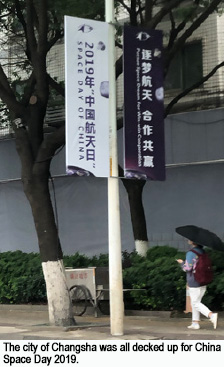China's Space Industry Has Come a Long Way
 BEIJING, May 2, 2019 — April 24 is China Space Day in China, a day more or less on par with Earth Day (i.e. a sort of non-holiday formal day of observation), and one which is met with a corresponding conference and exhibition, held in unconventional cities, including Harbin (2018) and Xi’an (2017).
BEIJING, May 2, 2019 — April 24 is China Space Day in China, a day more or less on par with Earth Day (i.e. a sort of non-holiday formal day of observation), and one which is met with a corresponding conference and exhibition, held in unconventional cities, including Harbin (2018) and Xi’an (2017).
This year’s edition of the conference was similar in this regard—with the riverside city of Changsha being an interesting choice—but was markedly larger than in year’s past, with several significant conferences being held concurrently in different parts of the city. With literally multiple hundred panelists in total across dozens of panels, no number of summaries could capture the full events of China Space Day 2019. With that said, my attendance across several different forums, events, and exhibitions led to a few main takeaways.
The State Still Gets Center Stage
Having attended a number of conferences in China over the past 18 months, one of the trends across conferences is the theme of the state getting center stage. This has historically involved local governments, major State-Owned Enterprises (SOEs), or other representatives of the state as the key guests at the conference, the people getting the keynote speeches, and the SOEs getting the largest booths in the exhibition hall.
In Changsha, it was no different, with varying representatives of the state getting prominent roles in the festivities. This included:
- Yang Liwei. Mr. Yang was the first Chinese person to be sent into space, when he went into orbit in 2003, and remains a hugely respected and revered figure within Chinese society (similar perhaps to John Glenn or others following their space accomplishments). Mr. Yang received an award during the opening ceremony, and was broadly lauded as a representative of the national space program, and by extension, the national government.
- Hunan Governor Xu Dazhe giving a major keynote speech during the opening ceremony, highlighting the capabilities of Hunan and the variety of companies that call the province home. Xu’s prominence at the conference could be said to be an indication of the local government’s influence in the conference but it is also a reflection of the unique importance of Governor Xu himself—indeed, he is noteworthy in that he is a former Chief Administrator of CASC and CNSA, as well as a major player in SASTIND—the very powerful governmental administration for state-owned enterprises. Given the relative absence of space-related companies in Changsha/Hunan, one might conclude that Xu’s various aerospace roles were a factor in bringing this conference there.
- The exhibit floor, whereby the largest booths, by some margin, were the state-owned companies and their subsidiaries (i.e. CASC, SAST, CALT, CAST, etc.), followed by some of the private companies that may have funding or other resources from the SOEs, followed by the purely private companies.
While there was a lot more participation from the private and commercial companies—and indeed, multiple sub-conferences focusing largely/purely on commercial space—the China Space Day conference remained, like most space conferences in China, dominated by the state in many aspects.
China Has Come a Long Way
 This year’s Space Day was markedly different from last year’s, primarily due to the fact that this year saw a UNOOSA space conference held concurrently with various other China Space Day Conferences. This led to several opportunities for China, which were exploited fairly well. First, a lot more foreigners came this year. The UNOOSA conference was at least half non-Chinese, with attendees hailing from South Asia, Southeast Asia, Sub-Saharan Africa, Europe, Latin America, and North America—that is to say, everywhere. While the international attendees primarily attended the UNOOSA event, the spillover effect involved the other conferences—those hosted by CNSA, Future Aerospace, etc.—having a more international attendance as well.
This year’s Space Day was markedly different from last year’s, primarily due to the fact that this year saw a UNOOSA space conference held concurrently with various other China Space Day Conferences. This led to several opportunities for China, which were exploited fairly well. First, a lot more foreigners came this year. The UNOOSA conference was at least half non-Chinese, with attendees hailing from South Asia, Southeast Asia, Sub-Saharan Africa, Europe, Latin America, and North America—that is to say, everywhere. While the international attendees primarily attended the UNOOSA event, the spillover effect involved the other conferences—those hosted by CNSA, Future Aerospace, etc.—having a more international attendance as well.
China’s use of soft power here was impressive, insofar as the UNOOSA conference was used as a way to highlight the achievements of China’s space program, in particular in its pursuit of win-win cooperation. Put another way, many of the UNOOSA speeches and panels were showcasing the various aspects of the Chinese space program in helping achieve the UN Sustainable Development Goals (SDGs), one of the main themes of the UN conference.
Separately, the marketing of the conference itself has advanced markedly over the past several years. 2019 saw a conference poster chock full of symbolism, and one that became a moderate viral hit due to the quality of its imagery. As first pointed out on Twitter by an industry observer, the 2019 poster is in particularly sharp contrast to the poster from the inaugural China Space Day in 2016.
On the whole, compared with previous conferences that I have attended in China related to space, this one felt as though the organizers had a better understanding of marketing, and a better understanding of how to position the Chinese space industry within the conference. This was partly due to the platform provided by the UN, but was also partly due to increasingly savvy behavior by China. Indeed, the inclusion of Russian astronauts, France as the guest of honor, and other countries’ representatives in the opening event, China likely accumulated much goodwill in the space domain during this event.
Separate to China’s progress in terms of soft power, the Chinese space industry had clearly come a long way in terms of actual development, particularly on the commercial side. This showed in several ways over the course of the week of the conference. On 23th April, a start-up China launch company, or Lingkong Tianxing, announced a successful experimental sub-orbital launch. The company can be considered purely a “second-generation” Chinese launch company, with its founder—Wang Yudong—being a former executive at OneSpace, before founding the company in 2018. On the same day, the deputy director of the CNSA, Wu Yanhua, Said that the CNSA would issue a special notice on the regulation of commercial launch vehicles, aiming to regulate the research, production, and experimental development activities of commercial launches.
In addition, the National Space Law was now included in the legislative plan of the 13th National People’s Congress Standing Committee, which will be included in commercial space activities. All the announcement showed the ambitions and the attitude of the administrations that commercial space is one part of China space activities and the administrations wants the companies to follow their rules.
Commercial space is a new concept in China, having only started in 2014. The ultimate outcome is completely unknown, but to now, the private and state-owned sector have seen some complementary development, although the private sector has been hampered by regulatory uncertainty. Moving forward, commercial space will continue to grow in China to a point, but eventually, the companies will need to deliver results (revenues, successful launches, operational constellations, etc.)
The Youth Will Take Over the World
Perhaps the most interesting aspect of the China Space Day events was the relative youth. The United Nations event had a large number of young people, including many students, which is to some extent to be expected. The private/commercial space industry events, though, were also full of young people, with the founders of most of China’s commercial space companies in their 30s. Even the SOEs and their subsidiaries are staffed primarily by fairly young people. On the whole, this is one area where China has a clear advantage, which is manifesting itself in more ways than one.
First, there are a lot of young Chinese aerospace engineers. Many of them stay in China. Second, though, there are many foreign students in China studying to be aerospace engineers (or similar). One specific example was the presence of the Beijing University of Aeronautics and Astronautics—Beihang University—at the conference in Changsha. Beihang is perhaps China’s premier aerospace university, with around 10,000 postgraduate students. In addition to having many Chinese representatives from Beihang (primarily graduate students and professors), there were an impressive number and diversity of non-Chinese Beihang students.
This includes a French friend of mine in Shenzhen, an Italian in Beijing, and a Bangladeshi whom I did not meet personally but heard ask a question during the conference. All three have, at some point, studied at Beihang University. Many of the future leaders of the space programs of the developing world will continue to go to Embry Riddle, MIT, etc., but increasingly, many are going to Beihang, Harbin Institute of Technology, or others. In a hard-to-define, but not insignificant way, this will likely lead to advantage China.
Conclusion
During a muggy, steamy week in April, the medium-sized city of Changsha became Space City, China. Executive VPs of China Great Wall rolled into town, the Wanda Vista Hotel got booked full by the United Nations, and the statue of Mao Zedong on Orange Island received more rocket scientist visitors than it had in years.
The conference(s) were an indication of China’s increasing assertiveness on the global space stage, but also a sign of the increasing degree to which there is, and will be, opportunities for collaboration between China and the outside world. Moving forward, the year between now and China Space Day 2020 will likely see the first commercial orbital launch by a Chinese company, the continued deployment of Chinese global LEO constellations, and the general development of the Chinese space industry at what we might call China Speed.
On my last day in Changsha, I was walking around a local Wanda Plaza Shopping Mall—a mall so large, that it had not one, but two very spacious Starbucks. Outside of the Pizza Hut, I spotted what looked like a space capsule. Sure enough, local smallsat company Spacety—one of the few Chinese New Space companies with headquarters in Changsha—had made a deal with the local pizza hut for a promotion. In this way, one day at a time, we are seeing space in China become more relevant to the masses.
----------------------------------
 Blaine Curcio is the Founder of Orbital Gateway Consulting. He’s an expert on the commercial space and satellite industries with a focus on the Asia-Pacific region. He can be reached at: blaine@orbitalgatewayconsulting.com.
Blaine Curcio is the Founder of Orbital Gateway Consulting. He’s an expert on the commercial space and satellite industries with a focus on the Asia-Pacific region. He can be reached at: blaine@orbitalgatewayconsulting.com.
 Tianyi Lan is founder of Ultimate Blue Nebula Co., Ltd., a space consulting company, and is an editor of Satellite World, a Chinese-language satellite news publication. He previously worked for CAST, and is based in Beijing. He can be reached at lantianyi@ubnebula.com.
Tianyi Lan is founder of Ultimate Blue Nebula Co., Ltd., a space consulting company, and is an editor of Satellite World, a Chinese-language satellite news publication. He previously worked for CAST, and is based in Beijing. He can be reached at lantianyi@ubnebula.com.





